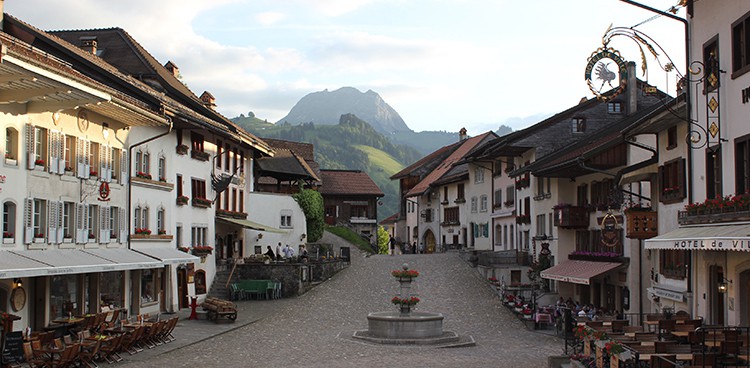
Cheese Expert Molly McDonough traipsed about Switzerland in search of the cows, people, and terroir that make Alpine cheeses so special for our Autumn 2015 issue. She had more amazing photos than could fit in the pages of our magazine, so here are some cream-of-the-crop extras to sate your Swiss cravings until you can pick up a wedge or visit the country yourself! Don’t have an issue or a subscription? Buy one today!

An alpage in the Vaud region of Switzerland. Each summer, cows are brought up to high-altitude pastures such as this to graze on fresh mountain grasses and flowers.

At an alpage in the Fribourg region, cheesemaker Beat Piller and his father work together to cut and stir curds, which will be turned into wheels of Gruyère Alpage.

Breakfast on the alpage: cheese, bread, coffee and the deliciously decadent crème double, or double cream. This famous 45-50% butterfat cream, which hails from the region of Gruyères, is best enjoyed slathered over a meringue and topped with berries.

High-altitude grasslands in Switzerland are famous for their rich and varied plant species, and the milk produced here is famous for reflecting herbal and floral flavors.

In the region of crème double, wooden cuillères à crème—“cream spoons”—are given as gifts at important events like weddings and births. The handmade carvings reflect the importance of wood as a material in these mountains and the meticulous craftsmanship that’s made Switzerland famous.

Beat Piller and his mother work together to lift the curds from the copper vat, which is heated using a wood fire.

Piller distributes the curd into big wooden Gruyère molds. The family produces only two wheels per day.

Wheels of Gruyère and Vacherin Fribourgeoise first age for a few days up on the alpage before they’re brought down the mountain for further aging, usually by a professional affineur.

Not all Gruyère is made on the alpage; most wheels are produced in village dairies, which use the same traditional recipe but with more modern equipment.

In Switzerland, affinage is an art. Jacques Ecoffey of Fromagerie Pringy shows us how he taps the cheese; the sounds it makes help him to control each wheel’s quality.

Affineur Roland Sahli carefully ages wheels of Emmentaler at his cheese cave in Langnau. His company, Gourmino, is exporting some of the highest-quality wheels of the famous Swiss cheese to the US market.

Switzerland’s first AOP-certified cheese, L’Etivaz can only be produced in summertime on the alpage, using heat from a wood fire.

This cheese cave owned by dairy company Emmi is built into the side of a hill in Moudon. Its 160,000 wheels of Gruyere are produced by different dairies throughout the region. A living product, each wheel needs to be treated with care.

The Valais region is famous for its Raclette cheese, traditionally produced using the milk of the native Herens or Eringer cow. Local pride in this stout, dark-colored breed is visible at the Raclette-producing village dairy of Eddy Baillifard in the Val de Bagnes.

The people of the Valais know that you don’t need a fancy toaster to enjoy raclette, just a fire and a good rock to rest the cheese on while the surface gets melty and bubbly. Scrape the wheel onto a potato and a cornichon and call it the perfect dinner.




